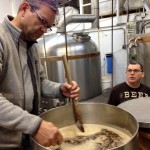The love child of ECAMP, Beer Geeks Anonymous and beer aficionado Jason Foster, our BrewCurious tour has been fermenting for nearly a year. In the midst of its planning, somebody posed a curious question: “What if someone could make a special edition brew using a historically inspired recipe?” After a flurry of emails back and forth, Neil Herbst of Alley Kat found himself intrigued at the prospect and committed to the project.
You see, Alley Kat is very aware of Edmonton’s brewing history. It was here that Sherbrooke Liquor Store’s Ochsner’s 1905 Alberta Porter was created, named for one of Edmonton’s first brewers. “We are a completely Edmontonian company, so we like to keep it close when sourcing,” Neil says. “We previously featured Charlie Flint’s Original Lager, named after an early Alberta brewer, and we’ve done Scona Gold, a reference to our neighbourhood. And we really like to buy local as much as possible when it comes to our ingredients.”
“Edmonton’s brewing history is a big mash up of every sort of brewer,” Neil continues. “We had a lot of Germans at the beginning of our brewing history, so a lot of pale ales and lagers, all really lightly hopped. The American influence is there too, some nice dark beers came from those brewers. Nothing was really pioneered in Edmonton as far as beer goes, but that water does give it a nice mineral taste.”
Jason Foster was put in charge of reproducing a heritage recipe based on some assumptions. This is how he describes it:
“In the early 1900s, stout was a style commonly sold by Alberta brewers. As no Alberta-based recipes are publicly available, the Girder Bender Historic Stout is based upon a late 1800s British recipe which would have been brought over by brewer immigrants, along with personal yeast strains. It has a very simple malt bill—pale malt, brown malt and black malt—reflecting brewers’ rudimentary roasting capacity of the time and quite different from stout recipes of today. A portion of the brown malt for the beer was home roasted to replicate the roasting processes of the early 1900s. Whole-leaf Goldings hops grown near Wabamun were used to add a local flavour to the beer. The yeast selected to ferment the beer is a strain likely to have been used by western Canadian brewers. The end product can be seen as an approximation of what thirsty patrons would have drank in the pubs of pre-prohibition Alberta.”
Jason should know. He’s a local beer writer and educator. In addition to being the beer columnist on CBC Radio One’s RadioActive and for Vue Weekly Magazine, Jason is the creator of onbeer.org, a website devoted to craft beer on the prairies. He writes for a variety of publications around the country and hosts beer tastings, beer dinners and educational events. He is a longtime award-winning homebrewer and a Certified Beer Judge. Jason is also an amateur social historian. So, yeah, Girder Bender’s got street cred.
The date was set to start the heritage brew. Shane Groendahl, home brewer and member of Edmonton Beer Geeks Anonymous, showed up to lend a hand. ECAMP was taken through Brewing 101. The barley had been roasted on Jason’s various grills (which answers the question “Can a Big Green Egg be used to get a dark roast?”) and was heated in a pot to release the sugars from the barley this grain stew is called the MASH.
The water and barley steep with repeated checks on the sugar content, as higher sugar content means higher alcohol content in the end product. Based on Neil’s final readings, the Girder Bender should be around 6%. Once happy with the sugar content, the wort (steeped barley water) was poured off leaving the spent grains in the Mash tun (pot). Spurging is the process of rinsing the mash with hot water allowing the water to pull as much flavour and sugar out of the grain and transferring it to the copper boil kettle.
The copper helps evenly heat the wort and this kettle is direct fired (i.e., burner underneath the pot)—which made for many propane fuelled pops when lighting it. Boiling allows flavours to be enhanced, sterilizes the wort and condenses the sugar. After the particles are filtered out and the wort is cooled, yeast is added to start the fermentation process.
Then we wait. At last report from Neil at Alley Kat the Girder Bender is a happy place for yeast to feed, breath and breed. We can’t wait to taste it.






